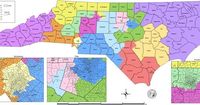North Carolina’s political landscape was upended this week as Republican lawmakers, following the urging of former President Donald Trump, finalized a new congressional map that could secure an additional GOP seat in the U.S. House ahead of the pivotal 2026 midterms. The move, which passed the state House on October 22, 2025, after a party-line vote in the Senate the day before, immediately triggered protests, accusations of racial gerrymandering, and promises of legal challenges from Democrats and voting rights advocates.
For many, the stakes could not be higher. The new map, now law since Democratic Governor Josh Stein lacks veto power over redistricting, targets the state’s only true swing district—North Carolina’s 1st Congressional District. This district, a majority-Black area represented by moderate Democrat Don Davis, has elected Black lawmakers continuously since 1992. Under the new boundaries, Republicans aim to shift the state’s congressional delegation from its current 10-4 GOP advantage to an 11-3 split, further consolidating their grip on power in a state where statewide elections are often razor-thin.
Republican leaders made no secret of their intent. “We’ll be sending another strong conservative to Washington to represent this great state,” Rep. Brenden Jones, the House Republican leader, declared on the House floor. According to NC Newsline, Jones added, “We did our job transparently, lawfully and unapologetically, and if that offends the left, so be it, because what we’re defending today is not just a map. It’s the principle that stops the deck from being stacked against us.”
The changes were designed at the explicit request of Trump, who has called on GOP-led states to redraw districts to shore up Republican control of Congress and avoid the usual midterm slump that often hampers the president’s party. Rep. Jimmy Dixon, another Republican, praised Trump as “the greatest president of my lifetime,” and said lawmakers were right to support his vision by redrawing the map. “I witnessed the divine intervention in preserving his life,” Dixon said. “He is a divinely changed man who loves this nation. I support the constitutional authority of this legislature to legally redraw our congressional districts.”
But the process has been anything but smooth. The map’s unveiling last week set off a torrent of opposition. According to Courthouse News, more than 12,000 public comments flooded an online portal, with Democratic Representative Pricey Harrison noting that only three were in favor of the new map. Rep. Beth Helfrich, a Democrat from Mecklenburg County, brought a stack of printed comments to the House floor to illustrate the depth of public concern, saying, “At no point in these proceedings has their input been meaningfully considered.”
Vocal protests erupted inside the legislative complex, with hundreds of activists—many from Democratic and liberal groups—accusing Republicans of doing Trump’s bidding through a rushed and unfair process. During Wednesday’s House debate, police cleared the gallery of protesters chanting about what they called “racist maps.” The tension was palpable, and the public’s frustration was echoed by lawmakers. “North Carolina is the testing ground for the new era of Jim Crow laws,” charged Rep. Gloristine Brown, a Black Democrat from Pitt County. “You are silencing Black voices and going against the will of your constituents.”
At the heart of the controversy is the reconfiguration of District 1, which critics say dismantles a historic Black opportunity district by dispersing Black rural voters who have helped elect a Black Democrat to Congress for more than three decades. Republicans, for their part, insist that no racial data was used in drawing the new lines. State Senator Ralph Hise, the map’s chief architect, said the changes were “specifically designed for political gain,” not race. “The claim of no racial data used is a legal shield to mask real-world tragedy,” countered Deb Oronzio, a resident who spoke during public comment. “You are effectively silencing the voices of Black North Carolinians and erasing their history of representation. This isn’t just partisan. This is a moral regression.”
Legal battles are all but certain. The 1st District, as it stood for last year’s election, is already part of an unresolved federal lawsuit alleging dilution of Black voting power. Former U.S. Attorney General Eric Holder, now leading the Democratic Party’s national redistricting efforts, called the new map “morally reprehensible and legally indefensible” and vowed it would be challenged in court. House Democratic leader Robert Reives predicted more litigation, telling reporters, “I’d be shocked if there was not legal action.”
The Republican response has been to point fingers at Democrats in other states. According to AP and Courthouse News, GOP leaders argue that blue states like California have drawn maps to maximize Democratic seats for decades. Senate President Pro Tempore Phil Berger defended the new map as “respecting the will of the North Carolina voters who sent President Trump to the White House three times.” He added, “North Carolina Republicans will not sit quietly and watch Democrats continue to ignore the will of the people in an attempt to force their liberal agenda on our citizens.”
For Rep. Don Davis, the implications are personal and political. Davis, a moderate known for working with Republicans, won his second term last year by less than two percentage points in a district that also backed Trump in the 2024 presidential race. He called the new map “beyond the pale” but confirmed he plans to run in 2026 if the map stands—either in the 1st or the newly redrawn 3rd District. Reives, the House Democratic leader, lamented the targeting of Davis, noting, “Don Davis busted his behind when he was here to work both sides. He busted his behind to compromise. And he’s going home.”
The public’s discontent with partisan gerrymandering is overwhelming. A September 2025 poll cited by Courthouse News found that 84% of North Carolinians, including majorities across party lines, oppose partisan redistricting. More than 70% support creating an independent commission to draw voting maps, while only 12% want lawmakers to continue the task. Yet, for now, the power to shape congressional districts—and potentially the balance of the U.S. House—remains firmly in the hands of the state legislature.
As candidate filing for the 2026 elections opens on December 1, all eyes are on the courts and the next moves from both parties. With Republicans holding a razor-thin majority in Congress and similar redistricting fights raging in states like Texas and California, North Carolina’s new map may prove to be a defining flashpoint in the national battle for political control.
In the end, the partisan lines may be drawn on a map, but the true boundaries—of representation, fairness, and democracy—are still being fiercely contested.






